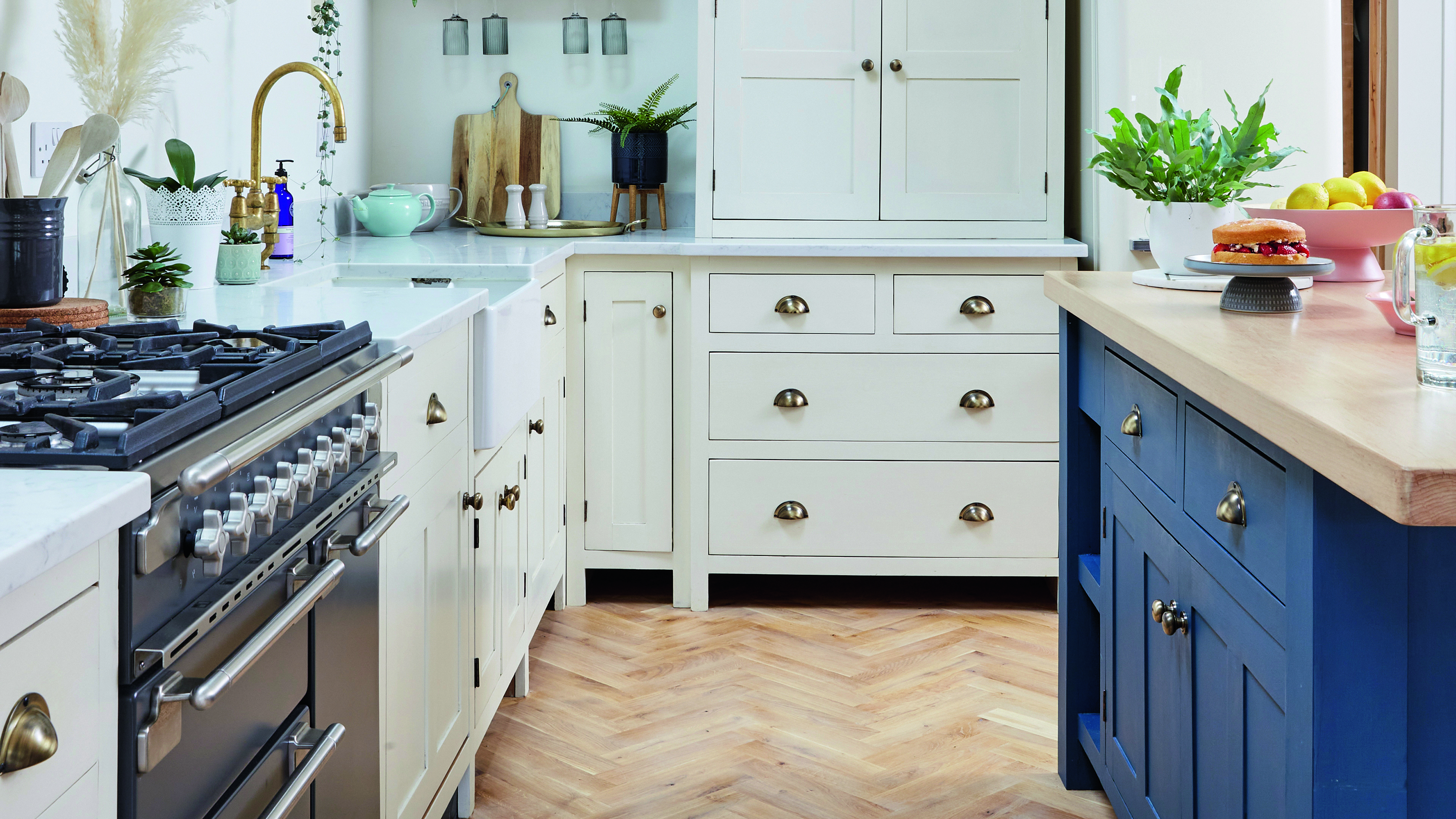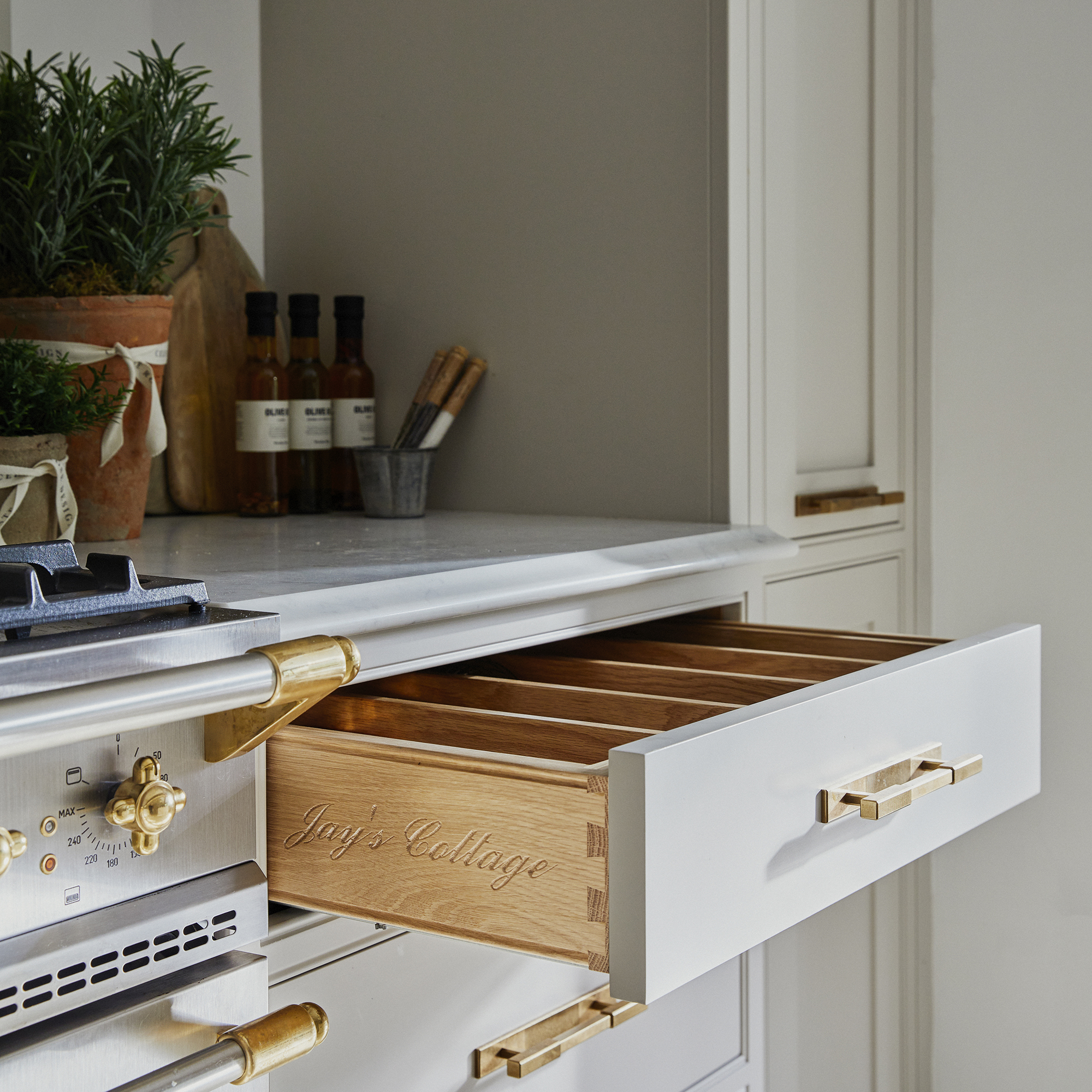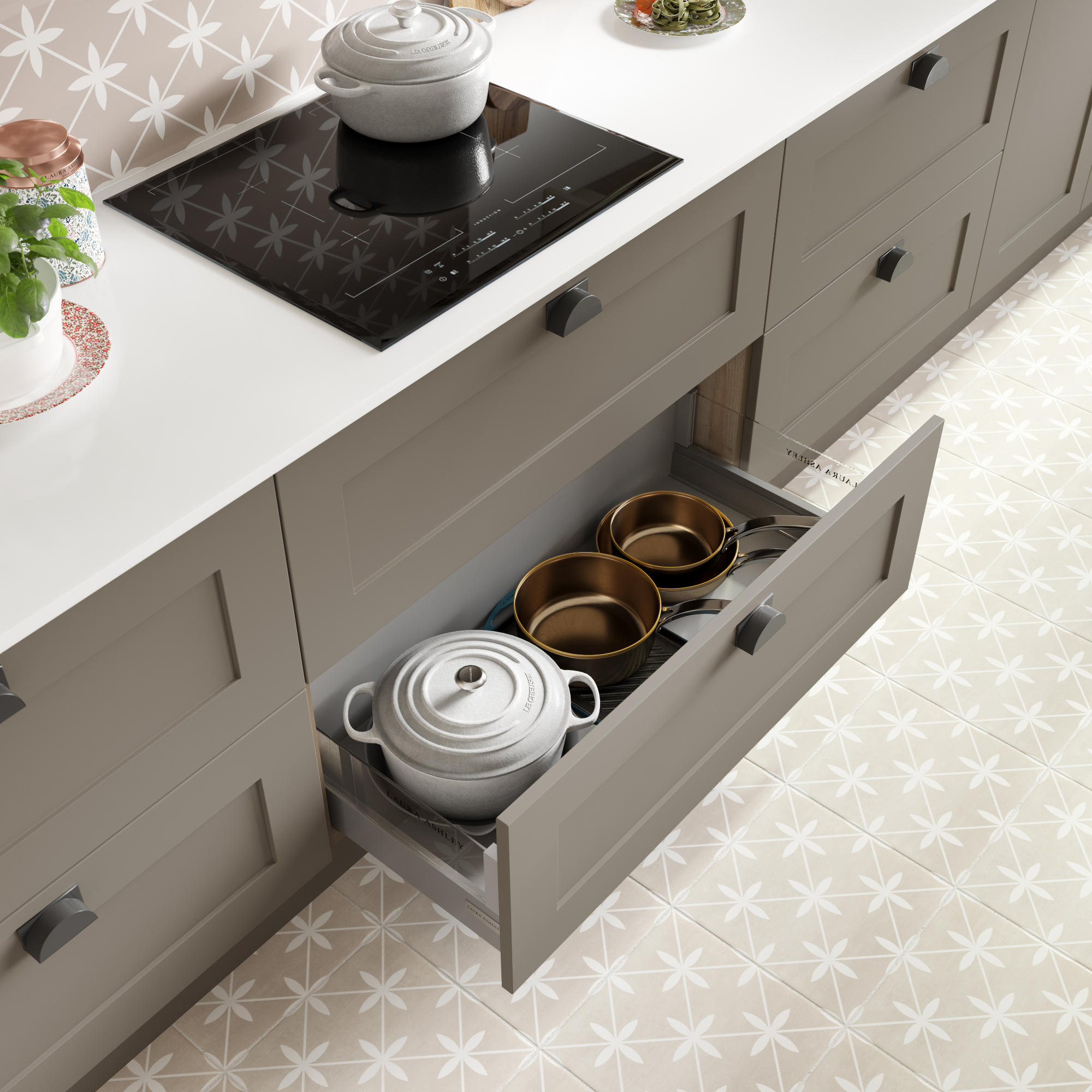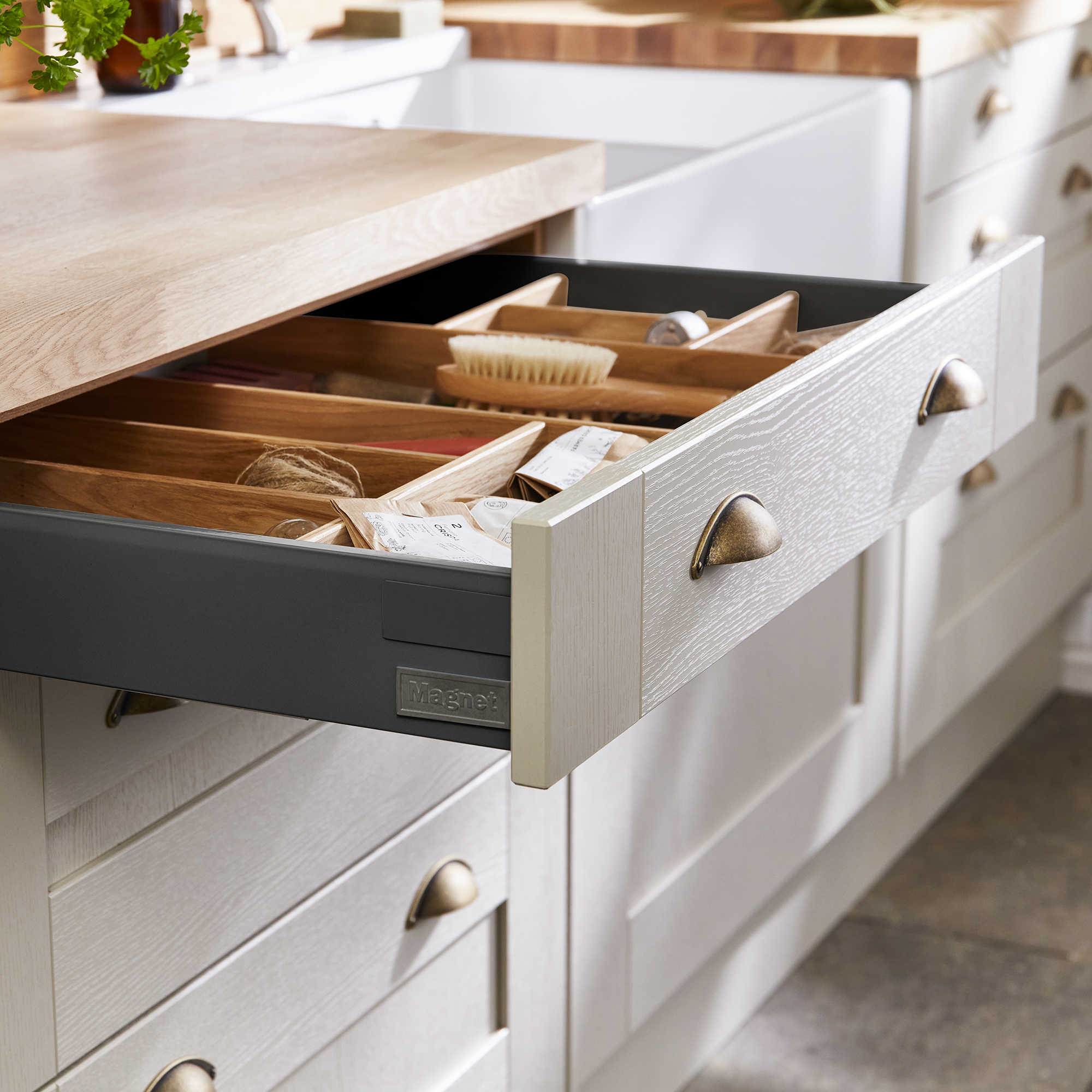These are the things you should never store in a kitchen drawer, according to organisation experts
Not sure what to keep where in your kitchen? We’ve got you covered


Time to admit something: we all have that drawer in our home – whether it be in the kitchen or hallway – that is crammed with stuff. It’s where everything lives, from takeaway menus and spare pens to an assortment of buttons, coins and probably birthday candles and receipts. But what should you never store in a kitchen drawer to help your space remain as organised as possible?
Even kitchen designers will admit they often include a drawer within a design for such stuff because, well, we all need somewhere to keep the odds and ends of real life. Where else would you put those menus and the phone number for the window cleaner?
But, there is a caveat. Along with the things we’ve mentioned that can happily live in a drawer, there are other things you should never store in a drawer, mainly for safety reasons and to keep your kitchen storage streamlined.
From the best way to store knives to keeping the drawer mechanisms working by not overloading them, we’ve taken a look at what might be better stored elsewhere, keeping the drawer space for something else. These tips will help keep your kitchen safe as well as organised.
Things you should never store in a kitchen drawer
Before you begin your kitchen organisation, step back and assess the lay of the land. How many drawers do you have, and do they vary in size and depth? Have you decided on more drawers vs cabinets or vice versa? Understanding the flow, function, and practicality of your kitchen drawers is the foundation for a well-organised space.
‘Think about the purpose of each drawer,’ says Dani Christie, professional home organiser and founder of The Organiser Next Door. ‘For example, if you have a drawer below your hob, store cooking utensils or lightweight pots and pans for easy access during meal prep. Opt for shallow drawers for cutlery and utensils, reserving deep drawers for larger items like serving dishes, plates, and dinnerware.
So what should be stored where and which kitchen storage trends should you ignore? We’ve taken the stress out of deciding with these things to avoid…
Sign up to our newsletter for style inspiration, real homes, project and garden advice and shopping know-how
1. Loose knives in drawers

It’s all too easy to allocate a section of your cutlery tray to sharp knives or bung them into a drawer with other utensils like wooden spoons and fish slices, but treating this cooking kit to its own solution is the best way forward.
Not only will an in-drawer knife block keep the sharp objects better organised so you can find what you need quickly and easily, but it’ll also prevent your knives from rolling around the drawer and protect your fingers when reaching in.
‘Consider using knife organisers or blocks within the drawer to keep the blades protected and separated, reducing the risk of accidents. Alternatively, magnetic strips or sheaths for individual knives can also be used to keep them secure and easily accessible,’ says Jane Thyeson, design lead at Smile Kitchens.
Or, why not use a countertop knife block and keep knives out of drawers, or create a display near the cooking area with a wall-mounted magnetic strip for the knives to stick to? Of course, just be sure to keep them out of reach of small hands.
2. Batteries out of their packaging

Batteries can leak and the fluid can cause damage to the inside of your drawers. Plus, you don’t want nasty chemicals making their way onto whatever else you have stored.
To avoid any of this, either keep batteries in their original packaging or use a zip lock bag or spare Tupperware box to keep them safely separated. This will stop you having to rummage around for that much-needed pair of AAs as well – we’ve all been there.
It’s also worth mentioning that batteries are best kept away from where children can reach, so consider a high-level cupboard instead of a drawer.
3. Heavy pots

‘If you're using drawers at home instead of cupboards, it's good to think about how you're spreading out the weight,’ says Jane. ‘While drawers are convenient for storage, excessive weight in them can strain their mechanisms and potentially cause damage or difficulty in opening and closing.’
This includes heavy pots, cast iron casseroles, pans, larger glassware like heavy bowls as well as things such as a pestle and mortar or chunky wooden boards.
Pay attention to the mechanisms and how strong they are. ‘If you’re going to use your drawers for lots of heavy items, runners need to be able to hold that weight. On the whole cheaper runners will not,’ says Rebecca Nokes, design director at John Lewis of Hungerford.
You may prefer to keep drawers for crockery and keep heavy cookware in cupboards instead.
4. Medicine on show
Just like batteries, keep medication high and out of reach unless required. ‘This makes drawers less suitable as drawers tend to be lower down and more accessible to all,’ says Dani.
Keep your medical essentials on the top shelf of a cupboard and use a box insert or caddy to keep everything organised.
5. Perishable food hidden away

While some perishable foods can find a home in drawers, ensure they are visible and not piled up to maintain freshness. The last thing you want is fresh food going mouldy and creating a mess at the bottom of your drawers.
If you must store any fresh food in drawers, stick with those that do best in cool, dry and dark environments, such as potatoes and other root vegetables. Consider investing in a netted or wicker basket to keep them together. Drawers are not temperature-controlled or airtight, so meat or dairy products or leftovers are best kept in the fridge.
For anything other food items kept in drawers, Dani says, ‘Clear rows allow for easy visibility, which helps to reduce your food waste too.’
6. Unlined drawers

While not a total necessity for organising, drawer liners will elevate the look of your drawers and protect them, helping them to last a lot longer.
‘I consider drawer liners as a practical luxury to protect your drawers from spills and scratches. They are easily removable and wipeable and they preserve the longevity of wooden or easily marked drawers,’ says Dani.
Liners that are slightly dimpled can help to stop loose parts from sliding around in your drawer, as the matt texture causes a slight resistance. Pair these liners with dividers and organisers for the foundation of a perfectly organised kitchen drawer.
7. Disorganised storage

The secret to nailing your storage is to assess what you have and then make sure everything has a home. This often means having a good declutter session beforehand too, so be critical of what you need and use and what you could do without.
Once you've decided on the items for each drawer, optimise organisation with storage solutions. ‘Drawer dividers are excellent for categorising, be it utensils or separating loose items like food packets and Tupperware,’ says Dani.
How to maximise storage in a small kitchen
If your kitchen is on the petite side, every last inch will have to work hard to get the best results. To maximise storage in a small kitchen, it’s all about being open to creative solutions and looking at the space from the very bottom to the very top.
For example, unit plinths could be turned into drawers for cooking trays, and voids between cabinets could provide enough room for slim oil bottles or a built-in wine rack or shelf for cookbooks. Building units right up to the ceiling will ensure that all available space is used, even if it means using a step to get to the top cupboards – simply store lesser-used items up there.
‘It’s important to maximise the space you have and think cleverly about storage solutions, as having too many units will close in the space. You will have more space to play with than you think, and so investing in magic corners, twin carousel corner cabinets, and even door storage, will eradicate the need for additional wall or floor storage units,’ suggests Darren Watts, showroom development and design director at Wren Kitchens.
Are kitchen cabinets better than drawers?
Plenty of deep drawers are often easier to access rather than cupboards, and where we do have cupboards some pull out storage makes life easier. But which is easier to organise?
‘Neither drawers or cupboards are inherently easier to organise,’ says Dani Christie, professional home organiser and founder of The Organiser Next Door. ‘The key lies in the systems you establish and the time you invest in maintaining them. Create a clutter-free, purposeful kitchen space with thoughtful storage solutions and maintaining it becomes second nature.’
Whatever your preferred choice, get rid of bulky items and things that you don’t use to ensure a super-efficient kitchen. You should make sure everything you keep is used and useful.

Lindsay Blair is an editor, writer & content consultant with a focus on home design, interiors & lifestyle. Previously editor KBB Magazine and thesethreerooms.com, she has also contributed to The Times, Ideal Home, Build It & more.